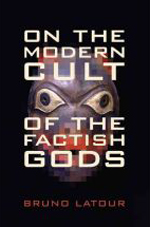On the Modern Cult of the Factish Gods

Very few men have made a lasting impression on me. One of them is Bruno Latour, who's not only one of the greatest speakers in France today, but an iconoclast with an aversion to iconoclasm and probably one of the most difficult 21st century sociologist-philosophers to read. Latour is a practicing Catholic who can make such illuminating comments as the one that it is wrong to spend time wondering whether the Virgin Mary, when the angel Gabriel saluted her, was a virgin or if she was being impregnated by spermatic rays. It's probably under the unknowing influence of Latour that my novel The Imitation of Patsy Burke took the strange turn it did, as Patsy plunged from the modern belief in the all-saving power of art to the old-time practice of prophecy.
In the March 8 edition of the London Review of Books there was an excellent review of Latour's latest book to be translated into English: On the Modern Cult of the Factish Gods. The review, titled Dolls, Demons and DNA was by Barbara Herrnstein Smith. Below is an excerpt from it that will give you an idea of where Latour is coming from.
"...In some quarters Latour's ideas have proved unsettling, not to say infuriating. His statements, often in garbled versions, were targets of choice for science warriors throughout the 1990s and continue to be cited (and garbled) in popular writings as examples of 'postmodernist' thought at its wildest. But significant and no less unsettling alternatives to prevailing accounts of scientific knowledge had been developed earlier by other historians, sociologists and philosophers of science, notably Paul Feyerabend, Ludwik Fleck, Thomas Kuhn, Michel Foucault and David Bloor. If Latour's work has caused particular distress, it is at least in part because of his flagrantly cosmopolitan style: witty, imaginative, literate and unrelentingly ironic. For some, all this spells something manifestly frivolous and naturally suspect. Others, including many not ordinarily drawn to treatises on science and technology, are attracted by Latour's style into engaging with ideas they find illuminating and a mode of analysis they can use...
In his second chapter, 'What Is Iconoclash?', Latour extends his analysis to art. Science, art and religion are all modes of image-making, he observes, but each involves 'different patterns of belief, rage, enthusiasm, admiration, diffidence, fascination and suspicion' with respect to representation. Scientific images, such as models, diagrams and satellite photographs, are representations of atoms, light and galaxies, but they are taken for the world itself. 'And yet … it slowly becomes clearer that without huge and costly instruments, large groups of scientists, vast amounts of money, and long training, nothing would be visible in such images. It is because of so many mediations that they are able to be so objectively true.' Contemporary art seeks to complicate our reaction to representations and make us aware of images' status as images. This art is, at the same time, iconoclastic, smashing every traditional aspect of art: image, canvas, paint, colour, patron, museum and indeed our understanding of what it is to be an artist. Yet 'the more art has become a synonym for the destruction of art, the more art has been produced, evaluated, talked about, bought and sold, and, yes, worshipped."







Published on April 02, 2012 05:36
No comments have been added yet.



